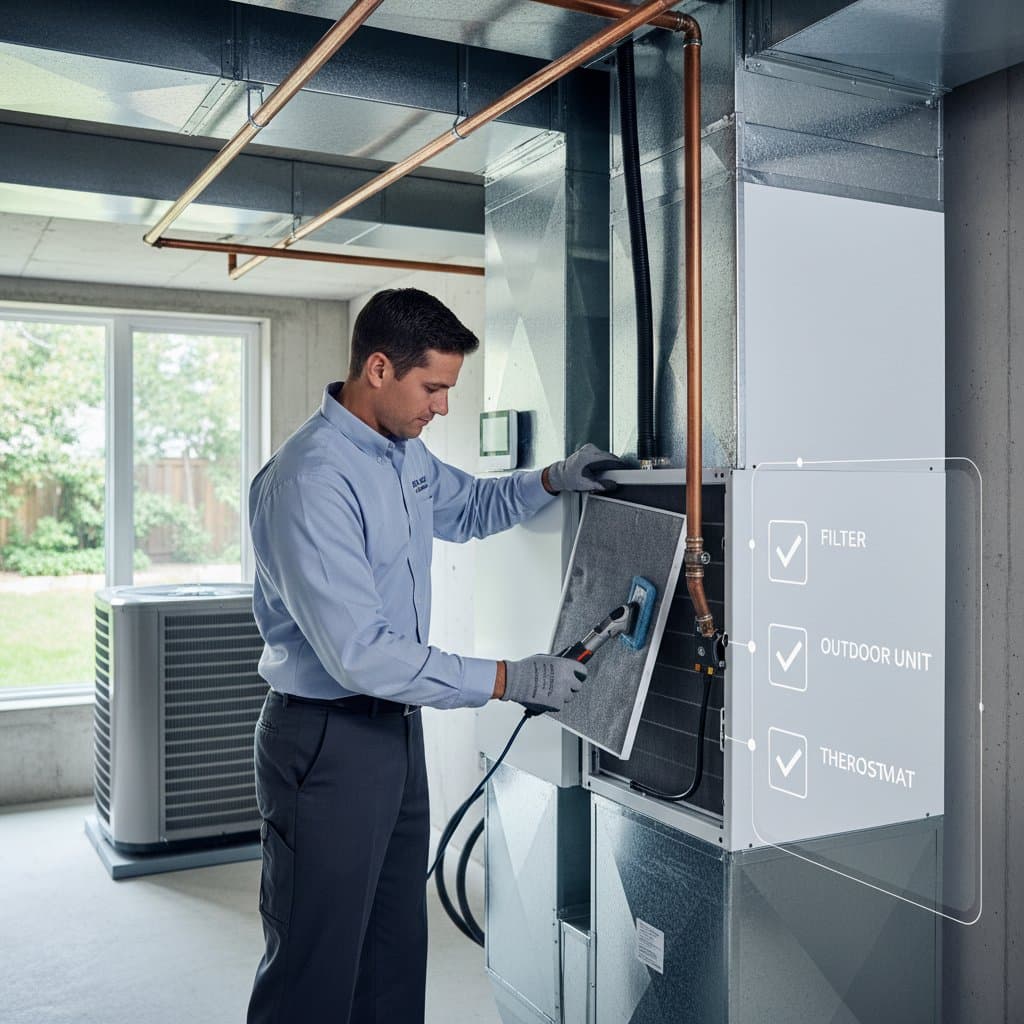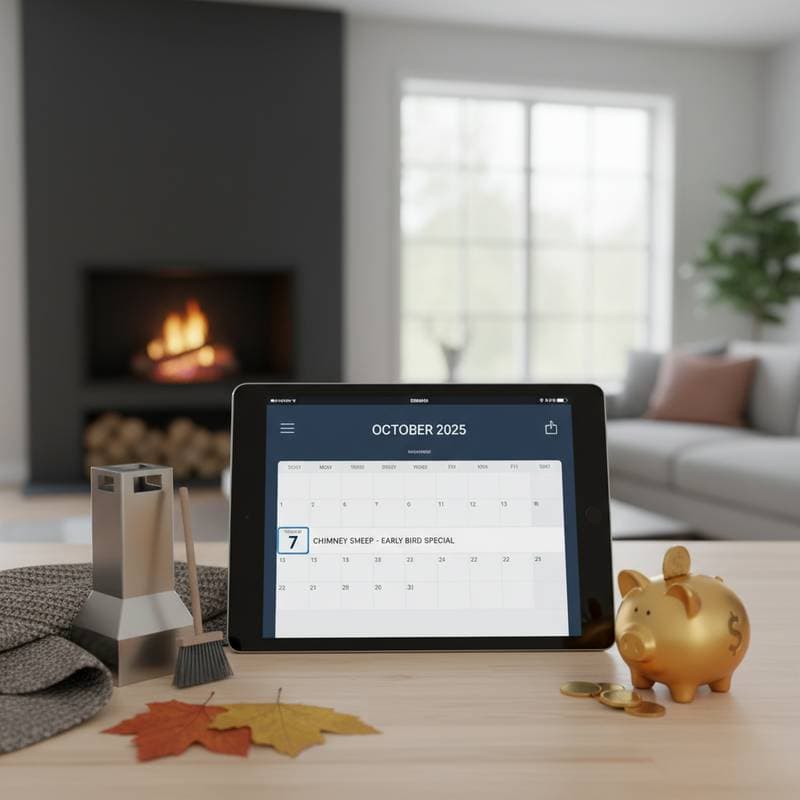Essential AC Tune-Ups to Prevent 5-10 Percent Annual Efficiency Loss
A quiet hum from the air conditioner signals reliable comfort as summer heat arrives. However, that comfort can fade if the unit fails to cool effectively or produces unusual noises. The encouraging aspect is that most significant failures can be avoided through straightforward tune-ups. Homeowners require no specialized HVAC expertise, only diligence, appropriate information, and basic tools.
This guide details precise checks, recommended frequencies, and indicators for professional assistance. Readers will gain knowledge of measurements, cleaning methods, and airflow objectives that maintain system efficiency and dependability throughout the season.
Step 1: Replace or Clean Air Filters
Clogged air filters represent the primary cause of diminished cooling performance. These filters impede airflow, compelling the blower motor to labor excessively and causing the evaporator coil to accumulate ice.
Actions to Take
- Identify the air filter location within the return air duct or adjacent to the blower compartment.
- Note the dimensions indicated on the filter frame, such as 16 by 25 inches or 20 by 20 inches.
- Exchange disposable filters every 60 to 90 days, or monthly during intense summer operation.
- For washable filters, rinse with mild soap and water, then allow complete drying prior to reinstallation.
Essential Specifications
| Filter Type | Efficiency (MERV Rating) | Replacement Frequency | Best Use |
|---|---|---|---|
| Fiberglass | 1 to 4 | Every 30 days | Budget protection |
| Pleated | 8 to 12 | Every 60 to 90 days | Standard households |
| High-efficiency | 13 to 16 | Every 90 days | Allergy-sensitive homes |
Maintain at least one inch of clearance around filter edges to facilitate unrestricted airflow. If the filter deforms or collapses, consider a reinforced frame or reduced MERV rating to minimize resistance.
Step 2: Clean the Outdoor Condenser Unit
The outdoor condenser unit releases heat extracted from indoor air. Accumulation of dirt, leaves, or debris on the coils reduces heat dissipation, leading to higher energy consumption and potential overheating.
Cleaning Procedure
- Turn off power to the unit at the breaker to ensure safety.
- Clear vegetation, debris, and obstructions from around the unit, maintaining at least two feet of clearance.
- Gently remove loose dirt from the fins using a soft brush or low-pressure hose; avoid bending the delicate fins.
- Apply a commercial coil cleaner if heavy grime is present, following product instructions, then rinse thoroughly.
Inspect for bent fins and straighten them with a fin comb if necessary. Perform this cleaning twice per season, especially in areas with pollen, dust, or nearby trees, to sustain optimal performance.
Step 3: Check the Evaporator Coil and Drain Pan
The indoor evaporator coil extracts heat from household air. Dust or mold accumulation diminishes efficiency, while drain pan overflow can result from blockages.
Inspection Steps
- Access the indoor unit by removing the panel.
- Examine the coil for frost, dirt, or rust using adequate lighting.
- Inspect the drain pan for any pooled water with a flashlight.
- Introduce one cup of white vinegar into the drain line to eliminate algae and maintain patency.
Should substantial buildup or ice formation appear, deactivate the system and consult a professional. Such conditions often stem from refrigerant shortages or airflow obstructions due to dirty filters or ducts.
Step 4: Inspect the Thermostat
An imprecise thermostat leads to excessive cycling and inconsistent temperatures.
Calibration Verification
- Adjust the thermostat to cooling mode and position a thermometer nearby.
- Allow ten minutes for stabilization, then compare the readings.
- If the variance surpasses two degrees, adjust the calibration or install a new unit.
Consider upgrading to a programmable or smart thermostat for enhanced control and reduced energy use. Position the device away from windows, vents, or heat sources to prevent inaccurate measurements.
Step 5: Test the Refrigerant Lines
Refrigerant deficiencies constitute the costliest repairs, frequently resulting from leaks that induce evaporator coil freezing.
Basic Assessment
Operate the system for fifteen minutes, then palpate the copper lines:
- The larger suction line ought to feel cool and condense moisture.
- The smaller liquid line should register warmth.
Equal temperatures on both lines or frost on the larger one necessitate a professional pressure evaluation. Refrigerant management demands EPA certification, prohibiting homeowner intervention.
Step 6: Lubricate Moving Parts
Unlubricated motors and fans risk overheating or failure. Although modern systems often feature sealed bearings, older units benefit from periodic lubrication.
Application Method
- Refer to the owner manual for designated lubrication ports.
- Employ non-detergent SAE 20 oil, dispensing three to four drops per bearing.
- Remove surplus oil to avert dust attraction.
This maintenance reduces operational noise and prolongs fan motor longevity.
Common Maintenance Errors to Avoid
Well-meaning efforts can falter without proper techniques. Homeowners frequently encounter these pitfalls:
- Delaying spring servicing until midsummer, which risks failures during high-demand periods.
- Installing incorrect filter dimensions, permitting air leakage and coil contamination.
- Applying high-pressure water to fins, which warps them and hampers airflow.
- Overlooking minor refrigerant leaks, allowing progression to compressor damage.
- Obstructing return vents with furnishings, which burdens the blower motor.
Addressing these issues enhances the effectiveness of routine tune-ups.
Required Tools
Assemble the following items prior to commencing:
- Screwdriver set, including Phillips and flathead types
- Soft brush or vacuum with appropriate attachment
- Garden hose equipped with spray nozzle
- Specialized coil cleaner
- Wet or dry vacuum
- Level
- Flashlight
- Thermometer
- Foil tape or mastic sealant for ducts
- Protective gloves and eyewear
Preparation with these tools streamlines the process and minimizes interruptions.
Accessibility and Safety Guidelines
Individuals with mobility limitations should prioritize indoor activities, such as filter changes and thermostat checks. Delegate tasks involving ladders or outdoor access to qualified technicians.
In residences with elderly occupants or heat-vulnerable persons, complete maintenance before seasonal warmth intensifies. Retain auxiliary fans or portable units as contingencies during servicing interruptions.
Expense Analysis and Efficiency Gains
A properly maintained air conditioner consumes 5 to 10 percent less energy annually compared to an unattended system. For a typical monthly cooling expense of 150 dollars, this translates to savings of 7.50 to 15 dollars per billing period.
| Task | DIY Cost | Professional Cost | Anticipated Savings |
|---|---|---|---|
| Filter replacement | 10 to 20 dollars | 25 to 50 dollars | 5 percent energy reduction |
| Coil cleaning | 15 dollars | 90 to 150 dollars | 5 percent energy reduction |
| Drain line cleaning | 0 to 5 dollars | 75 to 100 dollars | Avoids overflow issues |
| Duct sealing | 20 to 50 dollars | 300 to 500 dollars | 10 percent energy reduction |
| Complete tune-up | 0 to 100 dollars | 100 to 200 dollars | Averts major breakdowns |
Strategies for Sustained Performance
- Draw blinds during sunny periods to lessen cooling demands.
- Refrain from operating heat-producing devices in peak afternoon hours.
- Integrate smart thermostats that adapt to daily routines.
- Service outdoor coils biannually in environments with foliage or particulate matter.
- Employ surge protectors to safeguard electronics from electrical surges.
Implement Your AC Maintenance Plan
Regular adherence to these steps ensures consistent cooling, reduced expenses, and prolonged equipment life. Begin with a full inspection in early spring to prepare for the demands of warmer months. Professional support remains available for complex diagnostics, guaranteeing optimal system health year-round.





